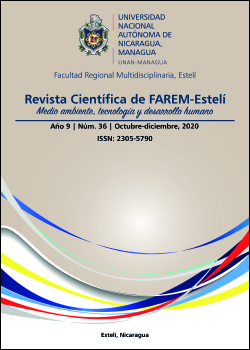Community participation and maternal health in Upper Wangky, from a gender perspective
DOI:
https://doi.org/10.5377/farem.v0i36.10612Keywords:
community participation, maternal health, gender perspectiveAbstract
The article, from the authors doctoral thesis, analyzes the perception of pregnant and postpartum women in Alto Wangky about the participation of their family, health professionals, and midwives to access health services during pregnancy, labor, and postpartum, expanding the map of facilitators or obstructors and integrating community organization and participation to the local maternal health management model. The gender focus explores dimensions not analyzed in classic positivist research, generating proposals for action and measures to influence policies on the subject. Type of qualitative research. A case study was carried out, with an intentional, flexible, and convenient sample. The main results show that the majority are women between 20 and 35 years of age, who are literate, unemployed, or work with job insecurity. They have access to reproductive services, but their access is difficult due to geographical conditions, or their husbands do not allow them to use them. They have prenatal services and use them; the labor is attended to more than 1 days journey by river. It is concluded that pregnant and postpartum women, with the support of their husband, family, and midwives, have access to available maternal health services despite the socio-economic and access difficulties in which they live.
Downloads
References
Asamblea Nacional. (14 de abril de 2008). Decreto Ejecutivo N° 19-2008. Declárese en Régimen Especial de Desarrollo para fines de atención del ejecutivo a los territorios Indígenas Miskitu, Indian Tasbaika Kum, Mayagna Sauni Bu y Kipla Sait Tasbaika, ubicados en la cuenca del Alto Wangki y Bokay. Managua, Managua, Nicaragua: La Gaceta, Diario Oficial Nº. 83 del 05 de Mayo del 2008.
Banco Mundial. (19 de Septiembre de 2018). Banco Mundal: https://blogs.worldbank.org/es/opendata/ el-numero-de-personas-extremadamente-pobres-sigue-aumentando-en-africa-al-sur-del-sahara
Banco Mundial. (04 de Abril de 2019). Banco Mundial. Recuperado el 07 de octubre de 2020, de Banco Mundial: https://www.bancomundial.org/es/topic/reproductivematernalchildhealth
CEPAL. (2019). CEPALSTAT: Bases de Datos y Publicaciones Estadísticas. 2000-2017. Santiago de Chile: CEPALSTAT. Obtenido de https://estadisticas.cepal.org/cepalstat/tabulador/ConsultaIntegrada. asp?idIndicador=41&idioma=e
D´Ambruoso, L., Evi, M., Yulia, I., Alice, K., & Anna, C. (07 de Mayo de 2012). Mortalidad materna y morbilidad severa en Indonesia Rural: La perspectiva de la comunidad. Medicina Social, 66-85.
Delgadillo, M. (2010). El bono demográfico y sus efectos sobre el desarrollo económico y social de Nicaragua. Managua: UNFPA, CEPAL CELADE.
FIDEG. (2019). Encuesta de Hogares para medir la pobreza en Nicaragua. Informe de resultados 2019. Fundación Internacional para el Desafío Económico Global (FIDEG). Managua: Red Panda Lab.
FIDEG, F. (2016). Encuesta de hogares para medir la pobreza en Nicaragua. Fundación Internacional para el Desafío Económico Global. Managua, Nicaragua. FIDEG.
Gobierno de Nicaragua. (Enero de 2008-2017). Informe de Gestión. Managua: Gobierno de Nicaragua.
Gómez, E. (1993). Género, Mujer y Salud en las Américas. En E. Gómez, Género, Mujer y Salud en las Américas (pág. 304). Washington, D.C.: OPS.
Humbolt, C. (5 de Octubre de 2011). Bosawas: Patrimonio Mundial de la Naturaleza. Managua, Managua, Nicaragua.
INEC. (2005). VIII Censo de Población y IV de Viviendas, 2005. Instituto Nacional de Estadísticas y Censos. Managua, Nicaragua. INEC.
INIDE. (2013). Encuesta Nicaragüense de Demografía y Salud (ENDESA) 2011/12. Instituto Nacional de Información de Desarrollo. Managua, Nicaragua. INIDE.
Martín-García, M., Ponte-Mittelbrun, C., & Sánchez-Bayle, M. (2006). Participación social y orientación comunitaria en los servicios de salud. Gaceta Sanitaria. Sociedad Española de Salud Pública y Administración Sanitaria, 192-202.
MINSA. (Julio de 2008). Marco Conceptual Modelo de Salud Familiar y Comunitario. Managua, Managua, Nicaragua: MINSA. Obtenido de minsa.gob.ni.
MINSA. (07 de Marzo de 2018). Ministerio de Salud. Obtenido de http://www.minsa.gob.ni: http://www.minsa.gob.ni/index.php/component/content/article/108-noticias-2018/3973-la-mujer-un-eslabon-importante-en-el-sistema-de-salud-publico
MINSA. (2019). Mapa de Mortalidad Materna. Obtenido de Mapa de Mortalidad Materna: http://www.minsa.gob.ni/pub/Mapa_Mortalidad_Materna_Nicaraguacierre%202020.pdf
MINSA. (2020). Mapa de mortalidad materna. Obtenido de Mapa de mortalidad materna: http://www.minsa.gob.ni/pub/Mapa_Mortalidad_Materna_Nicaraguacierre%202020.pdf
OMS. (1978). Conferencia internacional sobre atención primaria en salud. Kazajistán: OMS.
OMS. (2015). Global Strategy for Women´s, Children´s and Adolescents´Health 2016-2030. New York: United Nations.
OMS. (2018). Género y Salud. Washigton: OMS.
OMS. (19 de noviembre de 2019). OMS. Obtenido de Organización Mundial de la Salud: https://www.who.int/es/news-room/fact-sheets/detail/maternal-mortality
OMS, UNICEF, UNFPA, Banco Mundial. (2015). Evolución de la Mortalidad materna: 1990 a 2015. Estimaciones de la OMS, UNICEF, UNFPA, el Grupo del Banco Mundial y la División de Población de las Naciones Unidas. Ginebra, Suiza: Organización Mundial de la Salud.
ONU. (2018). Progreso hacia los Objetivos de Desarrollo Sostenible, Informe del Secretario General. New York: Naciones Unidas. Obtenido de Naciones Unidas.
OPS-OMS. (07 de Octubre de 2020). Organización Panamericana de la Salud, Organización Mundial de la Salud. Recuperado el 07 de octubre de 2020, de Organización Panamericana de la Salud, Organización Mundial de la Salud: https://www.paho.org/es/temas/salud-materna
Pardo, T., & Hansell, T. (2018). Retos y transformaciones: liderazgo comunitario y gobernanza territorial indigena en el alto Wangki Bocay. Raíces: Revista Nicaragüense De Antropología, 34-43.
PNUD, & OPHI. (11 de julio de 2019). Programa de Naciones Unidas para el Desarrollo, Iniciativa de Oxford sobre Pobreza y Desarrollo Humano. Obtenido de https://www.undp.org/content/undp/ es/home/news-centre/news/2019/2019_MPI_New_data_challenges_traditional_notions_of_rich _and_poor.html
Downloads
Published
Issue
Section
License
Copyright (c) 2020 Revista Científica de FAREM-Esteli

This work is licensed under a Creative Commons Attribution-NonCommercial-ShareAlike 4.0 International License.

